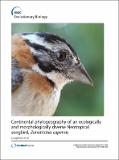Por favor, use este identificador para citar o enlazar a este item:
http://hdl.handle.net/10261/142683COMPARTIR / EXPORTAR:
 SHARE SHARE
 CORE
BASE CORE
BASE
|
|
| Visualizar otros formatos: MARC | Dublin Core | RDF | ORE | MODS | METS | DIDL | DATACITE | |

| Título: | Continental phylogeography of an ecologically and morphologically diverse Neotropical songbird, Zonotrichia capensis |
Autor: | Lougheed, Stephen C.; Campagna, Leonardo; Dávila, José A. CSIC ORCID ; Tubaro, Pablo L.; Lijtmaer, Darío A.; Handford, Paul | Palabras clave: | Rufous-collared sparrow Pleistocene DNA sequences Colonization Demographic expansion Intraspecific divergence |
Fecha de publicación: | 2013 | Editor: | BioMed Central | Citación: | BMC Evolutionary Biology 13: 58 (2013) | Resumen: | [Background]: The Neotropics are exceptionally diverse, containing roughly one third of all extant bird species on Earth. This remarkable species richness is thought to be a consequence of processes associated with both Andean orogenesis throughout the Tertiary, and climatic fluctuations during the Quaternary. Phylogeographic studies allow insights into how such events might have influenced evolutionary trajectories of species and ultimately contribute to a better understanding of speciation. Studies on continentally distributed species are of particular interest because different populations of such taxa may show genetic signatures of events that impacted the continent-wide biota. Here we evaluate the genealogical history of one of the world's most broadly-distributed and polytypic passerines, the rufous-collared sparrow (Zonotrichia capensis). [Results]: We obtained control region DNA sequences from 92 Zonotrichia capensis individuals sampled across the species' range (Central and South America). Six additional molecular markers, both nuclear and mitochondrial, were sequenced for a subset of individuals with divergent control region haplotypes. Median-joining network analysis, and Bayesian and maximum parsimony phylogenetic analyses all recovered three lineages: one spanning Middle America, the Dominican Republic, and north-western South America; one encompassing the Dominican Republic, Roraima (Venezuela) and La Paz (Bolivia) south to Tierra del Fuego, Argentina; and a third, including eastern Argentina and Brazil. Phylogenetic analyses suggest that the Middle American/north-western South American clade is sister to the remaining two. Bayesian and maximum likelihood coalescent simulations used to study lineage demographic history, diversification times, migration rates and population expansion together suggested that diversification of the three lineages occurred rapidly during the Pleistocene, with negligible gene flow, leaving genetic signatures of population expansions. [Conclusions]: The Pleistocene history of the rufous-collared sparrow involved extensive range expansion from a probable Central American origin. Its remarkable morphological and behavioral diversity probably represents recent responses to local conditions overlying deeper patterns of lineage diversity, which are themselves produced by isolation and the history of colonization of South America. | Versión del editor: | https://doi.org/10.1186/1471-2148-13-58 | URI: | http://hdl.handle.net/10261/142683 | DOI: | 10.1186/1471-2148-13-58 | Identificadores: | doi: 10.1186/1471-2148-13-58 e-issn: 1471-2148 |
| Aparece en las colecciones: | (IREC) Artículos |
Ficheros en este ítem:
| Fichero | Descripción | Tamaño | Formato | |
|---|---|---|---|---|
| songbird.pdf | 1,93 MB | Adobe PDF |  Visualizar/Abrir |
CORE Recommender
PubMed Central
Citations
6
checked on 06-mar-2024
SCOPUSTM
Citations
39
checked on 16-abr-2024
WEB OF SCIENCETM
Citations
33
checked on 26-feb-2024
Page view(s)
220
checked on 23-abr-2024
Download(s)
365
checked on 23-abr-2024

